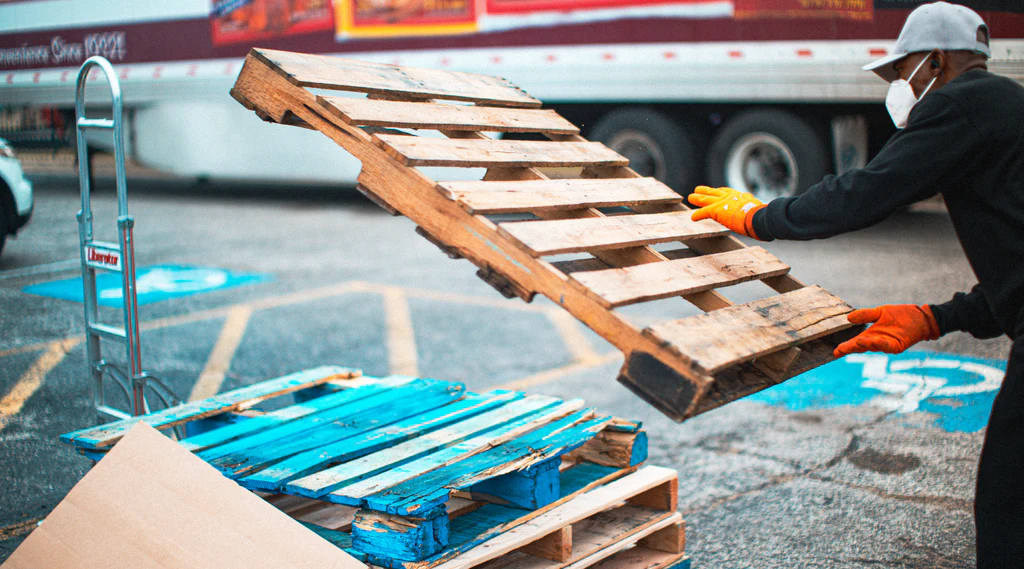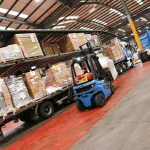
Heavy-Duty Wooden Pallets and Their Role in Reducing Freight Damage in Kenya
When Kenyan businesses move goods — whether from farm to warehouse, warehouse to port, or across borders — every bump, shift or delay can lead to freight damage. The good news is that using heavy-duty wooden pallets early in the supply chain can make a big difference. In fact, the focus keyword Heavy-Duty Wooden Pallets appears right away because it’s integral to understanding how logistics in Kenya can become more efficient, less costly, and more reliable.
Introduction to heavy-duty wooden pallets
Heavy-duty wooden pallets are specially designed platforms made from robust wood (for example eucalyptus, cypress or strong pine) and built to withstand substantial loads, frequent handling, and repeated use. In Kenya they are increasingly seen as the smart base solution in warehousing, transportation and export logistics. According to Kenyan industry commentary, these pallets are engineered for high-load capacity, repeated use, and long-term durability. (deka.co.ke)
For Kenyan exporters, manufacturers, warehousing firms and logistics companies, the choice of pallet matters. A poor pallet can lead to crushed goods, lost shipments, higher insurance claims and wasted resources. A heavy-duty wooden pallet helps prevent these risks, creating a stable and consistent foundation for goods in transport. This article explores how these pallets help reduce freight damage in Kenya, what makes them effective, what to watch out for, and how Kenyan businesses can benefit.
The Kenyan logistics and freight environment
Kenya’s logistics and freight environment presents specific challenges. Roads can be rough, handling equipment may be inconsistent, warehouses may operate under varied conditions (humidity, dust, outdoor storage) and exporters face international standards and time-sensitive shipments.
Studies in Kenya show that goods damage rates in logistics can hover between 4-7 %. For example, one logistics analysis noted that premium durable wooden pallets could reduce damage by 30-40%. (deka.co.ke) Freight damage comes not only from rough road conditions or poor packaging but from instability, improper stacking, shifting loads and inadequate support during transit.
The cost of freight damage is direct (lost goods, returns, replacements) and indirect (delays, customer dissatisfaction, higher insurance or compliance costs). Using the right pallet is one of the key preventative measures.
Common causes of freight damage in Kenyan supply chains
- Loading/unloading mishandling: When goods are not properly secured on pallets, the movement during forklift or truck handling causes tilting, tipping or drop-damage.
- Poor packaging or insufficient support: If goods sit directly on the truck floor or on inadequate pallets, they are vulnerable to shock, crush or abrasion.
- Moisture, pests and environment: Especially in perishable exports (like fruits, vegetables or flowers), pallets that absorb moisture, harbour pests, or allow poor ventilation can worsen damage. In Kenya, exports must often meet phytosanitary conditions. (deka.co.ke)
By using a heavy-duty wooden pallet, many of those causes are mitigated — the goods are elevated, secured, stable and better supported.
What makes a pallet “heavy-duty”
To qualify as heavy-duty in the Kenyan context, a wooden pallet typically features:
- Strong wood species (e.g., eucalyptus, cypress) that can handle high loads without warping. (deka.co.ke)
- Robust construction: thicker deck boards, reinforced stringers, well-spaced boards, solid workmanship. (deka.co.ke)
- Higher load capacity: able to handle 1,000 kg or more, repeated stacking, forklift movement.
- Proper treatment: heat-treated or fumigated to meet export standards (such as ISPM-15) for pest prevention and durability. (deka.co.ke)
- Good maintenance and repairability: ability to be inspected, repaired, reused. (deka.co.ke)
These features distinguish them from light or medium-duty pallets which may succeed for local retail but may not survive heavy exports, rough handling or repeated reuse.
Advantages of using heavy-duty wooden pallets in Kenya
Damage reduction: data & case-studies
Using heavy-duty wooden pallets leads to measurable benefits. For example, one analysis estimated that using durable wooden pallets could cut damage rates by around 30-40% in Kenyan logistical operations. (deka.co.ke)
In a Kenyan agricultural export case, switching to properly treated wooden pallets for avocado and flower shipments resulted in significant reduction in product rejection and spoilage. (deka.co.ke)
By keeping goods elevated, stable and properly supported, the risk of bruising, crushing, shifting or rejection is reduced.
Improved handling and stacking
Heavy-duty wooden pallets provide a stable base for forklift and pallet-jack operations, quicker loading/unloading, better stacking in warehouses, reduced manual handling errors. For example, one Kenyan case found warehouse throughput improved and labor incidents reduced once better pallets were used. (deka.co.ke)
Export readiness and compliance
For exporters in Kenya — especially fresh produce exporters — compliance is vital. Wooden pallets when properly treated (for pests, moisture) meet the global standard ISPM 15 and avoid shipment rejections. (deka.co.ke)
Using heavy-duty wooden pallets signals to buyers and regulators that the supply chain is professional, safe and reliable.
Comparison: Wooden pallets vs alternatives in Kenyan context
When comparing wooden pallets to plastic or metal alternatives in Kenya, several factors emerge:
- Wooden pallets: Lower initial cost, locally available, repairable, recyclable. Good load capacity when robustly built. But they may wear out faster, need treatment and quality control. (deka.co.ke)
- Plastic pallets: Higher upfront cost, long lifespan, easy to clean, resistant to moisture/pests — but may not be as locally supported in Kenya, may have import dependency. (deka.co.ke)
- Metal pallets: Very durable, heavy, higher cost, perhaps over-engineering for many Kenyan SMEs.
In many Kenyan settings, heavy-duty wooden pallets strike the best balance of cost, local supply, durability and functionality.
Implementing palletisation: best practices for Kenyan businesses
To get the maximum benefit from heavy-duty wooden pallets, Kenyan businesses should adopt these best practices:
- Choosing the right pallet: Confirm load capacity, wood species, construction quality, treatment certification (especially for export). (deka.co.ke)
- Maintenance & repair: Regular inspection for cracks, loose nails, warping. Repair damaged boards rather than discarding entire pallet. Store pallets properly (dry, off ground) to avoid moisture damage. (deka.co.ke)
- Proper handling and stacking: Use forklifts/pallet jacks, don’t drag pallets; stack evenly; avoid overloading; align loads to pallet centre; secure goods to pallet to prevent shifting.
- Training: Warehouse staff should be trained on pallet handling, inspection and damage prevention.
- Inspection routines: Before loading, inspect pallets for condition, ensure treatment stamps if exporting. (deka.co.ke)
By following these practices, the lifespan of pallets increases, freight damage drops, and the investment pays off.
Sustainability and circular economy
Heavy-duty wooden pallets also support sustainable logistics in Kenya:
- Local sourcing: Kenya has a timber industry supplying wood for pallets, reducing reliance on imports and supporting jobs. (deka.co.ke)
- Reuse and repair: Wooden pallets, unlike many one-way packaging solutions, can be repaired and reused multiple times—extending lifecycle and reducing waste. (deka.co.ke)
- Recycling: At end-of-life, pallets can be chipped into mulch, fuel or repurposed. This circular approach reduces environmental footprint. (deka.co.ke)
Such sustainable logistics practices align with Kenya’s growing emphasis on environmental responsibility and green growth.
Challenges and considerations for Kenyan firms
Despite their advantages, using heavy-duty wooden pallets in Kenya involves some challenges:
- Wood supply and deforestation risk: Sustainable sourcing of timber is critical; otherwise the wood supply may become constrained and costs may rise. (deka.co.ke)
- Moisture, pests and quality variation: If pallets absorb moisture or are infested by pests, they may fail or cause contamination—especially for exports. Treatment and proper storage are necessary. (deka.co.ke)
- Standardisation across supply chain: If different players use different pallet sizes or load ratings, inefficiencies and damage risks increase. Investment in common standards helps. (deka.co.ke)
- Upfront cost and perception: Some businesses may perceive heavy-duty pallets as an extra cost rather than an investment. ROI must be explained. (deka.co.ke)
By anticipating these issues and building them into procurement and logistics planning, Kenyan firms can maximise the pallet advantage.
Future trends and opportunities in Kenya’s pallet market
The pallet industry in Kenya is evolving. Key trends and opportunities include:
- Pallet leasing or pooling systems: Businesses sharing pallet assets or renting heavy-duty pallets rather than owning them outright.
- Smart pallet tracking: Embedding RFID or barcode tags in pallets allows real-time asset tracking, improved inventory visibility, and better damage prevention. (deka.co.ke)
- Local manufacturing growth: Demand for robust heavy-duty pallets creates opportunities for Kenyan sawmills, carpenters and small manufacturers to build capacity.
- Custom pallet solutions for exports: As Kenya’s fresh produce export industry grows (avocados, mangoes, flowers), tailored heavy-duty wooden pallets designed for cold-chain, container shipping and international compliance will become increasingly important. (deka.co.ke)
These developments mean that choosing heavy-duty wooden pallets is not just a logistics decision—it’s a strategic asset for Kenyan businesses aiming to scale and export.
Conclusion
In summary, heavy-duty wooden pallets play a fundamental role in reducing freight damage in Kenya. By providing a stable, elevated, robust base for goods in storage and transit, they help cut down on crushing, shifting, spoilage and compliance rejections. For Kenyan exporters, manufacturers and logistics firms, the adoption of such pallet systems can translate into lower damage costs, fewer returns, stronger customer trust and improved export competitiveness.
Moreover, because wooden pallets are locally available, repairable, sustainable and cost-effective compared to alternatives, they are well-suited to Kenya’s logistics realities. That said, success depends on choosing the right pallet, maintaining it properly, ensuring compliance (especially for exports), and integrating it into a well-managed supply chain.
If you are involved in Kenyan freight, warehousing or export operations, heavy-duty wooden pallets deserve a central place in your logistics strategy.
Frequently Asked Questions
- What is the typical load capacity of a heavy-duty wooden pallet?
Heavy-duty wooden pallets in Kenya are often built to handle loads of 1,000 kg or more, depending on design, wood species and construction. The exact amount should match the load requirements of the goods. - Why is treatment such as heat-treatment important for wooden pallets?
For international shipments, pallets often need to comply with phytosanitary standards (like ISPM-15) to ensure no pests or harmful organisms hitch a ride. Heat-treatment or fumigation reduces the risk of rejection at destination. (deka.co.ke) - Can using heavy-duty wooden pallets really reduce freight damage?
Yes. Studies indicate that switching to durable wooden pallets can reduce damage rates by around 30-40% in Kenyan logistics operations. (deka.co.ke) - How do wooden pallets compare cost-wise with plastic or metal pallets in Kenya?
Wooden pallets generally have lower upfront cost and are locally repairable and recyclable. Plastic and metal alternatives may last longer or offer hygiene benefits but come with higher costs, and for many Kenyan SMEs wooden pallets hit the sweet spot of cost vs benefit. (deka.co.ke) - What maintenance is required for heavy-duty wooden pallets?
Key maintenance steps include: regular inspection (for cracks, loose nails, warping), proper storage (dry, off ground), repair of damaged boards/stringers, and ensuring they do not get overloaded or mishandled. (deka.co.ke) - Are there sustainability benefits to using wooden pallets in Kenya?
Absolutely. Wooden pallets can be sourced locally, repaired and reused, and at end-of-life they can be recycled (e.g., into mulch or biomass). This supports circular economy goals and reduces environmental impact. (TA PALLET PRODUCTS)





Add a comment